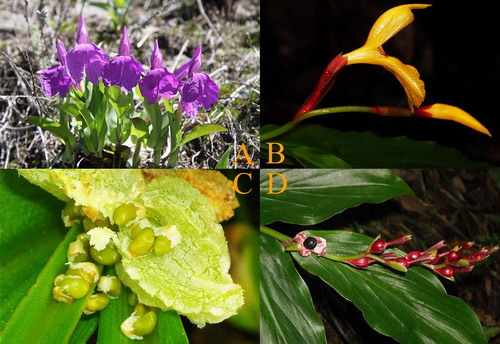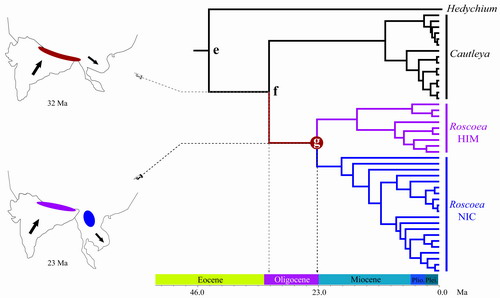Cautleya and Roscoea are two high-elevation genera in ginger family distributed in the Pan-Himalaya, with different species richness and geographic distribution. They also differ in morphology and life history, especially the dispersal ability of seeds. The evolutionary diversifications of many taxonomic groups, especially those with limited dispersal ability, are often driven by key geological events, such as tectonic drift, continental collisions, and uplifts of mountains.
Prof. LI Qingjun and his team of Xishuangbanna Tropical Botanical Garden (XTBG) have been engaged in the studies of ginger family for many years. In a recent study, they aimed to use Cautleya, Roscoea and their close relatives as a model system to test the correlations between evolutionary diversification of this group and major geological events in the studied region. They proposed that the contrasting distribution patterns in Cautleya and Roscoea have been affected not only by the geological history of the region, but also the differences in their morphology and life history, especially the dispersal ability of seeds. Furthermore, they hypothesized that within the genus Roscoea, the separation between the Himalayas (HIM) and the Northern Indochina (NIC) species can be attributed to the vicariant evolution caused by the early uplift of the Himalayan–Tibetan Plateau as well as the rapid lateral extrusion of Indochina at the same time.
The researchers reconstructed the biogeography of Cautleya and Roscoea through fossil-calibrated phylogeny. They integrated multiple lines of evidence in alpine gingers to test the correlation between evolutionary diversifications of plants and successive occurrence of tectonic events. They also addressed basic questions about the timing of the early uplift of the Himalayan–Tibetan Plateau and rapid lateral extrusion of Indochina.
The well-supported monophyly of Cautleya and Roscoea and the clear separation between the two genera in their molecular diversity, elevational distribution, and fundamental life history traits suggested that their diversifications were probably driven by two early uplifts of the Himalayan–Tibetan Plateau. Phylogenetic and molecular dating analyses of Roscoea suggested that the HIM and NIC species, with a ~ 500 km wide gap separating the disjunct areas, are reciprocally monophyletic. Ancestral area reconstructions indicated that Roscoea originated in the Himalayan region and then expanded its ranges to occupy both HIM to NIC.
Their results indicated that the common ancestor of Cautleya and Roscoea originated at around 44 million years ago (Ma), and divergence between Cautleya and Roscoea occurred at around 32 Ma, which two periods are associated with two-early rapid uplifts of Himalayan-Tibetan Plateau. Splitting between Roscoea in the Himalayas and Roscoea in the north of Indochina occurred at around 23 Ma, which was consistent with the rapid extrusion of Indochina as well as the third uplift. The results also indicated that herbaceous species with the reduced ability for long-distance seed dispersal and restricted pollen flow may harbor unique genetic imprints that reflect ancient geological and environmental changes in this region.
This research is the first case that mirrored continuous geological events using one plant group in the world. Their study entitled“Evolutionary diversification of alpine ginger reflects the early uplift of the Himalayan-Tibetan Plateau and rapid extrusion of Indochina” has been published online in Gondwana Research.

Flower and fruit of Roscoea (A, C) and Cautleya (B, D).


